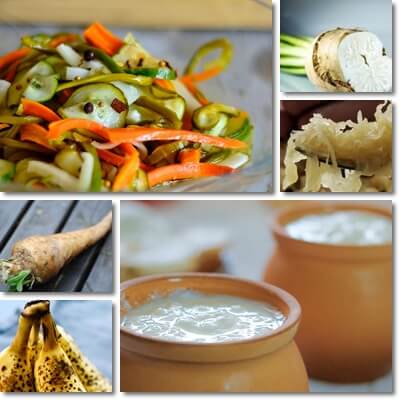Good general health relies heavily on having healthy gut bacteria populations. And the foods we eat help determine the numbers and types of bacteria in our gastrointestinal system as well as the health benefits we may enjoy as a result of their presence. Some foods are better than others when it comes to feeding the good bacteria in our gastrointestinal system and increasing their populations. They are called prebiotics and probiotics.
Prebiotic foods are foods rich in dietary fiber, plant material we can’t digest or absorb, but which gut bacteria synthesize and feed on. Prebiotics are fermented foods that contain live, beneficial bacteria that complete existing good gut flora populations for better digestive and overall health. Eating natural prebiotic and probiotic foods for gut bacteria is the simplest and easiest way to enjoy digestive health. The benefits of a balanced gut flora are diverse and cover multiple systems. For example, gut bacteria can promote weight loss naturally, ferment fiber and participate in producing several essential nutrients.

What vitamins do gut bacteria produce? Well, the good gut bacteria populations synthesize vitamin K, vitamin B1, vitamin B2, biotin or vitamin H and the all-important vitamin B12 and vitamin B9. In addition to this, they help keep pathogenic bacteria populations under control and contribute to the immune function. And these are only a few of the wonderful good gut bacteria benefits. Gut bacteria decide the overall utility of the gut as a system for the digestion of food, synthesis of essential nutrients, with endocrine-like functions and a real and visible impact on the nervous and immune systems.
Considering the huge factor a healthy gut flora plays in determining both digestive and overall health, it is only normal we look to foods that boost good bacteria populations, notably probiotics and prebiotics. And some of the best foods to eat for gut health are:
1) Plain yogurt
Also known as sour yogurt or Greek yogurt. This is really the only yogurt we should be eating as it’s undoubtedly the healthiest dairy for gut flora. Plain yogurt is a dairy product made from whole milk and added bacterial cultures, essentially beneficial gut bacteria, which ferment the milk to obtain the final product: yogurt. Because it contains live, beneficial bacteria, yogurt is a probiotic food.
Plain yogurt is supposed to be sour as a result of the fermentation process, but not too sour. If it becomes too sour to the taste, develops a bad smell, mold or changes color, it’s no longer good to eat. Yogurt can be made from all types of milk and usually contains Lactobacillus and Bifidobacteria. All the bacteria cultures in yogurt add to the beneficial gut flora populations and boost gastrointestinal health.
2) Soured milk
Soured milk is a dairy product obtained naturally from fresh milk. It is made from fresh milk left one or more days at room temperature or in a slightly warmer environment so that the bacteria present naturally in the milk (usually Lactobacillus) can ferment it. This results in a sour-tasting, acidic milk with probiotic properties, a great food to eat for gut health. Soured milk that is obtained through natural fermentation of existing bacterial cultures is also called fermented milk. Soured milk obtained by the deliberate addition of an acid like acetic acid in vinegar or citric acid in lemon juice to give it an acidic taste is correctly called acidified milk. Home-made, naturally fermented soured milk remains a superior product and probiotic food with a better, richer flavor profile, thicker, creamier texture and guarantees a generous load of beneficial bacterial cultures. And no, soured milk is not spoiled milk.

3) Buttermilk
Another excellent probiotic food for healthy gut flora is traditional buttermilk which is the milk left over from churning butter. Buttermilk is actually different from soured milk. Soured milk is produced from whole milk by natural fermentation and is slightly tart, but thicker and creamier (compared to milk in general). Buttermilk is the remaining liquid part of milk that is left after churning butter. In a way, buttermilk is a fermented, skim, soured, very liquid milk containing live beneficial bacterial cultures. If produced using a traditional method, it may contain tiny lumps of fat (essentially leftover butter that couldn’t be or wasn’t removed). Buttermilk is a product more similar to whey than milk. Also read about the Properties and Benefits of Whey Powder.
4) Kefir
Kefir is a traditional probiotic food, similar to a thin, sour yogurt with a fizz. It is produced from cow’s milk, sometimes goat milk, and using kefir grains or kefir cultures. What are kefir grains? In simple words, kefir grains consist of a complex of specific milk-fermenting live bacteria such as Lactobacillus kefiranofaciens and yeasts. Kefir grains are shaped like broccoli or cauliflower florets and usually white in color, with a sort of jelly-like texture. They are added to milk to ferment it and produce a specific probiotic drink called kefir.
Because of fermentation, lactose content of kefir is estimated to be low which has certain nutrition experts recommend it for those who are lactose intolerant. However, as an acidic, slightly alcoholic, effervescent, probiotic milk product, kefir can take some getting used to. As such, if you do not drink milk or eat dairy on a regular basis, it might be best to introduce it slowly into your diet so you don’t experience side effects such as abdominal discomfort, a feeling of stomach heaviness, acid reflux or rashes. The benefits of eating kefir (the real one, made in the traditional way using kefir grains, not the commercial, pseudo-kefir made from various bacterial cultures) include antimicrobial action, immuno-modulating and healing properties.
5) Kimchi
Kimchi is a traditional Korean pickled vegetable dish and a great food for gut health. The dish can be made from a wide variety of vegetables, with cabbages and radishes being staple ingredients. Kimchi is traditionally salted with sea salt, but also chili powder, ginger, garlic, green onions and extremely salted seafood like anchovies or shrimp. What makes kimchi a great food for gut bacteria is the fact that it contains a great variety of lactic acid bacteria which makes it a probiotic and excellent amounts of dietary fiber which makes it a prebiotic too. Examples of beneficial bacteria include Lactobacillus kimchii, Lactobacillus brevis, Bacillus mycoides, Lactococcus lactis etc. Consumption should be limited because a high or regular intake of acidic foods like pickled vegetables or vinegar can increase the risk for stomach cancer.
6) Pickled cabbage or sauerkraut
The European kimchi, sauerkraut, is essentially pickled cabbage. Traditional sauerkraut is made from finely chopped cabbage leaves that are salted and left to ferment naturally. In Eastern Europe, whole cabbages were stuffed into barrels which were then filled with water and salted generously, then left to ferment over winter. The whole leaves would either be used chopped in stews of boiled, pickled cabbage seasoned with bay laurel leaves or to make rolls of meat or rice stuffed cabbage. Sauerkraut is a prebiotic thanks to the fiber content of cabbage and a probiotic because the natural fermentation process results in the formation of a great variety of beneficial gut bacteria cultures. Depending on how far along the fermentation process is, sauerkraut may contain different bacterial cultures in varying amounts.
7) Pickled vegetables in general
Pickles are a source of both beneficial live bacteria to complement existing gut flora and fiber to feed these populations, making them both probiotic and prebiotic foods. Cruciferous vegetables like cauliflower, broccoli, different cabbage varieties, kale, as well as radishes, beets, carrots, cucumbers, olives, peppers, bitter gourd, garlic, onions, unripe tomatoes, bamboo shoots, jicama, bitter gourd, daikon radishes are some of the most widely available pickled vegetables. Fruits like watermelon, citron, yuzu, green papaya, unripe guava are also examples of foods that can be pickled.
Pickles are essentially heavily salted food products and can be kept in brine (salted water solution) or in an acidic liquid (vinegar, also with the addition of salt). Fermentation then takes places and beneficial live bacterial cultures are formed. While the beneficial bacteria enrich our existing gut flora, the fiber from the vegetables and fruits themselves serves as food for existing and newly-formed gut flora.
8) Fermented bean paste and beans
Fermented bean paste and beans, including food products such as natto, tempeh and tofu, contain varied microflora which can hold benefits for gastrointestinal health, contributing to an increase in beneficial gut bacteria populations. The fiber in the bean paste products further contributes to feeding gastrointestinal microflora, prompting a healthy gut ecosystem. Fermented soybeans (natto) are made through the addition of Bacillus subtilis cultures and represent both a probiotic and prebiotic food. Tempeh is a fermented soybeans paste cake and may contain vinegar or other acidic liquids to prompt fermentation. Tofu is a type of curdled soybean milk that can be fermented to produce stinky tofu or pickled tofu.
9) High fiber foods
All foods high in dietary fiber (indigestible plant material) hold prebiotic properties. What this means is that special gut bacteria ferment the dietary fiber we don’t digest and use it as food source. Whole grains, legumes, vegetables of all kinds and especially inulin-containing vegetables (garlic, onions, bananas, artichokes and coffee substitutes like burdock root, chicory root and dandelion root) as well as fruits, nuts and seeds of all sorts make great prebiotic foods for a healthy gut flora.
Side effects of fermented foods
No food is without its side effects. Prebiotic and probiotic foods in particular have the potential to produce the most adverse reactions, despite their excellent contribution to gut flora health. Ironically, the most side effects affect the gastrointestinal system. Probiotic milk products such as sour yogurt, soured milk, buttermilk, kefir and even cheeses can cause abdominal discomfort, bloating, gas, burping, acid reflux, nausea, vomiting sensation, stomach heaviness, loose stools and diarrhea as well as headaches and even hives. Plant-based probiotic and prebiotic foods (fermented and pickled) can cause similar side effects as well as heartburn, acid reflux, gastritis or worsening of existing gastritis or ulcers and irritable bowel manifestations. They can also be a source of allergic reactions. Pickled foods eaten in excess increase the risk for stomach cancer and esophageal cancer by producing acid reflux.
Eating foods for a better gut flora can ultimately help you enjoy better digestion, but can also be a source of gastrointestinal upset. Given their acidic nature, foods that are good for a healthy gut should be introduced slowly, one at a time and eaten in small amounts over the course of several weeks to allow your digestive system to get used to them. Remember your gut flora needs time to adapt to synthesizing particular compounds in foods.
Conclusion
If you’re wondering what foods to eat for healthy gut bacteria, then know fermented, pickled and high-fiber foods are the best as they hold both probiotic and prebiotic properties. Examples include plain, sour yogurt, fermented milk products like soured milk, buttermilk, kefir, even hard cheeses, pickled vegetables, either mixes like kimchi or plain pickled vegetables like sauerkraut, pickles or pickled beets, unripe tomatoes or watermelon, fermented beans products, including natto and tempeh and plant foods rich in dietary fiber.
